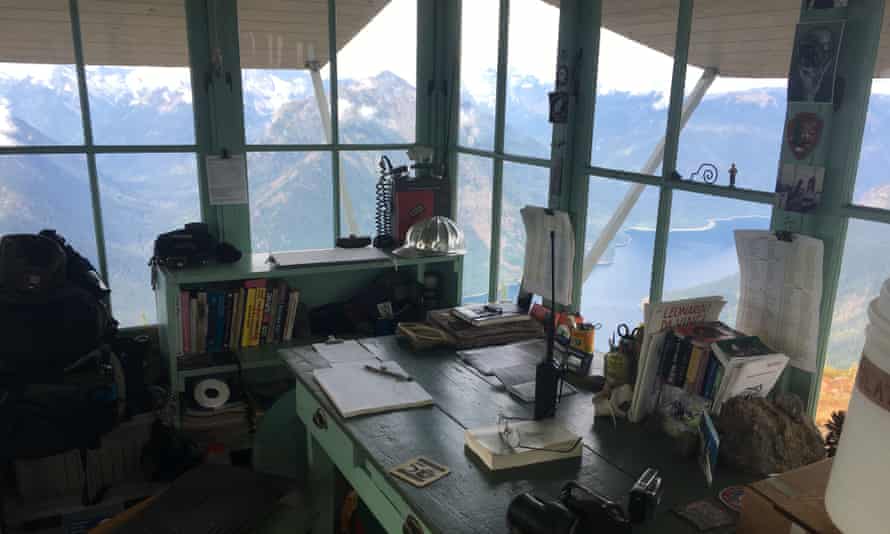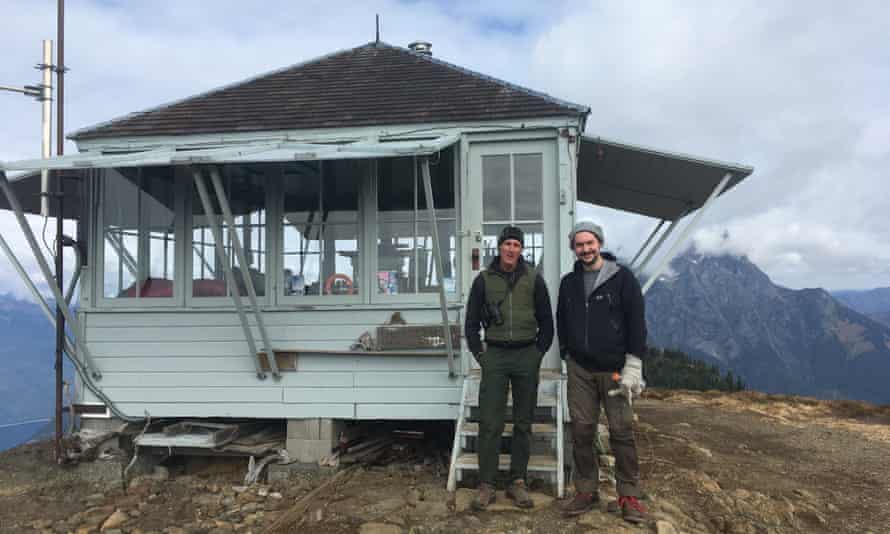A few years ago, I travelled to the Cascade mountains of Washington state to research fire lookouts – crow’s nests for smoke spotters to raise the alarm in case of forest fires. My goal was Desolation Peak, the cabin where rookie vedette Jack Kerouac spent 63 eventful days in the summer of 1956.
At the time I was writing a book about far-flung and abandoned beacons, sheds, and ghost towns. Of all the outposts, Desolation Peak (1,860 metres tall, about six miles south of the Canada-US border) was perhaps the riskiest in terms of who I’d meet when I got there because, unlike Big Creek Baldy in Idaho (yes, that was its name), Desolation Peak was still staffed and in service. So I knew that there was someone sitting on top of the mountain. I was going to hike up to their cabin and it would be pot-luck whether they’d be an enthusiast and welcome me in or a grizzly jobsworth who’d tell me to get stuffed.
With my longsuffering friend Colin, I drove north from Seattle on Interstate 5, then east along the Skagit River and into the densely forested Cascades. The journey took 48 hours with a stopover in a Bates-style motel in the one-horse town of Marblemount – the last services for 70 wild miles of boscage and bears.
Next morning, we traversed a series of dams before zooming 20 miles up Ross Lake in a powerboat driven by a taciturn lumberjack. The rest of the day, we hiked pine needle paths beneath western red cedars and ponderosa pines with trunks a couple of metres across; trees so high that the Pacific silver firs below appeared as mere ankle-biters. Up and up Desolation we went until, near dusk, we emerged near the top and pitched our tent.
Having set up camp, we set off for the summit, slaloming past boulders and spinneys and into snow, a granular crush on a rise from where we could see the low pyramid roof of the summit belvedere. It was a wonderful moment. Then we saw a figure. A tall man, walking down from the hut. He saw us at the same moment. He waved. We waved back and met on the path a minute later.

“Hello”, he said, “I was just going out for a stroll around.”
He hadn’t expected to meet anyone. Would we like to come up and see the cabin? He was Jim Henterly, the Desolation Peak fire watchman.
From afar, he’d looked forbidding. I’d had the thought then, a split second after he’d seen us but before he waved, that here was The Man come to tell us to scram, piss off back down the mountain. But Jim was all smiles and, as if in added welcome, alpenglow suddenly flared to flood the summit hot pink and lit up the cabin.
We all went in and Jim set to making us tea, telling us the cabin’s history as he lit the stove and got the kettle going. The sun cut gold across the panelled room, dazzling on a central brass turntable, picking out the books on the desk, the sleeping bag neatly doubled on the mattress. The huge panorama of the windows – mountains shadowed blue and saturated red. You could see it all from that marvellous glass pagoda.
“You can see right into Canada,” he gestured with his mug once we were all settled with a drink.

In the time it had taken to make the tea he’d told us that the cabin was an L-4 built in 1932, described how the whole thing would have been carried up as a kit by pack horses and mules; explained that the circular apparatus in the middle of the room was an Osborne Fire Finder; that its crosshairs were horse tail – nothing else did the job so well.
He swivelled the sights to zero in on prominent peaks – Prophet, Terror, Challenger, Fury, Ruby, Baker – way off yonder in the glowing haze; beckoning us over to have a go. He showed us how the windows opened, noted that the cabin’s green was a shade of paint named Irish Meadow, showed us his Pulaski hatchet – a kind of fire-fighting Swiss Army axe. And then, quite suddenly, it was dark and night was here. How long had we been talking?
“I guess I’m a kind of evangelist for the historical lookout experience,” he said, turning on the central light.

Fire lookouts had their heyday between 1930 and 1950. There once were more than 10,000 watchers staffing more than 5,000 watch stations in the US alone, but those numbers were massively reduced with the advent of satellite imaging and mobile phones. However, Jim’s role is still vital in the great wireless-free wilderness of the Cascades and these days, as well as watching for telltale smoke trails from lightning strikes, ready to radio and direct firefighters, he acts as a radio relay for rangers and trail crews in the peaks around.
He had something of the actor Matt Smith about him – the look of “a young man made by old men from memory”. Kindly, craggy, lean and tall – head almost brushing the ceiling. Timelord Jim, alone up in his Irish Meadow Tardis bathed in radio static, materialised here on the mountain. Watchman, medic, radio relay, army veteran, teacher, artist, raconteur …
“The motto of my army division was ‘Rendezvous with destiny’,” he said. “The motto of my battalion was Ne desit virtus – Let valor not fail.”
I’m delighted to report that we’re still in touch.
Most recently he wrote to share his sadness at the passing of the great nature writer Barry Lopez, signing off with a quote from Arctic Dreams:
“The edges of any landscape – horizons, the lip of a valley, the bend of a river around a canyon wall – quicken an observer’s expectations. That attraction to borders, to the earth’s twilit places, is a part of the shape of human curiosity.”
Dan Richards is the author of Outpost: A Journey to the Wild Ends of the Earth (Canongate), which is available to buy at The Guardian Bookshop





